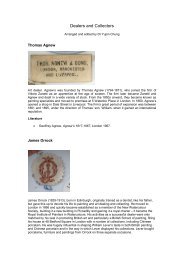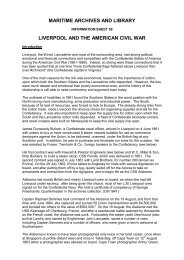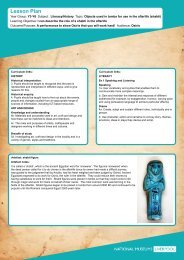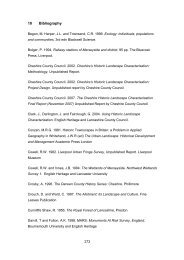full Contemporary Slavery Teachers' Resource - National Museums ...
full Contemporary Slavery Teachers' Resource - National Museums ...
full Contemporary Slavery Teachers' Resource - National Museums ...
You also want an ePaper? Increase the reach of your titles
YUMPU automatically turns print PDFs into web optimized ePapers that Google loves.
seCTIon B<br />
3. Responding to statements<br />
These statements are designed to encourage debate about exploitative relationships<br />
between adults and children; between employers and workers; and to highlight issues of<br />
children’s rights.(The following statements use the term “employer” for boss. If the pupils<br />
are more familiar with the term “boss”, use that.)<br />
Ask the students to imagine an invisible line in the classroom which runs through five<br />
points: strongly agree; agree; not sure; disagree; strongly disagree. Read the following<br />
statements and ask the students to stand on that line . After each statement ask two<br />
students standing at different points to explain to the class why they are standing at<br />
that particular position.<br />
• Parents have a right to ask their children to do some housework.<br />
• Parents are entitled to ask children to do an hour’s housework every day.<br />
• People should always be able to talk to each other while they are working.<br />
• If you have worked an 8-hour day but still have a task to finish, your employer has<br />
the right to make you work overtime.<br />
• People who work for someone else will always be exploited.<br />
• If you see a fellow worker being mistreated by your employer, you should speak<br />
out even though your employer might be angry with you.<br />
• Children aged under 14 should never be encouraged to do paid work.<br />
• If your employer offers you more money to do dangerous work, you should refuse<br />
to do that work.<br />
• exploitation and slavery are the same thing.<br />
Plenary<br />
Ask the students to comment on the activities and learning they have done in this<br />
lesson. Ask if they can think of some kinds of child labour that would not be slavery,<br />
and where the line should be drawn between them.<br />
Homework/further research<br />
explain that there are pieces of human rights legislation that relate to these issues.<br />
Ask the pupils to do some research about the Un Convention on the Rights of the Child.<br />
42<br />
Hope Academy, Merseyside, at<br />
International slavery Museum,<br />
national <strong>Museums</strong> Liverpool.<br />
Key Stage 3 Lesson 2<br />
Objectives/desired outcomes for students:<br />
• to know about different kinds of contemporary slavery and identify common features.<br />
• to know that there have been national laws and international conventions to<br />
challenge contemporary slavery.<br />
• to consider why slavery continues when there are laws against it.<br />
Curriculum links: Citizenship 1.1b); 1.1c); 1.2a); 1.2b; 1.2c); 2.1a); 2.1b) see pages 32-33.<br />
<strong>Resource</strong>s needed<br />
Case studies with questions/discussion points.<br />
Worksheet 3.2.1: <strong>Contemporary</strong> slavery is…<br />
Worksheet 3.2.2: A summary of human rights/children’s rights conventions regarding<br />
child labour/slavery.<br />
Key vocabulary: case study, slavery, violated.<br />
seCTIon B<br />
Introduction<br />
Recap from the previous session. Ask what they learned and whether there are any<br />
issues they would like clarified.<br />
Ask students to work in groups and come up with a sentence about what they think<br />
it means to be a slave. share the sentences that groups come up with and record<br />
their answers.<br />
Activities<br />
1. Case studies – reading and discussion<br />
Remind the students that the previous class included a case study on what has been<br />
described as contemporary slavery. explain that in this lesson they will be given other<br />
true case studies to help them identify the features of contemporary slavery.<br />
split the class into four groups. Give each group a case study (choose four from the case<br />
studies with the relevant questions and discussion points on pages 56-67). each group<br />
will need to appoint a scribe, a timekeeper and someone as the main narrator to report<br />
back. Give each group a set time to read the case study, answer the questions, discuss,<br />
and prepare a short presentation for the other groups about their case study.<br />
<strong>Contemporary</strong> slavery Teachers’ <strong>Resource</strong> <strong>Contemporary</strong> slavery Teachers’ <strong>Resource</strong> 43


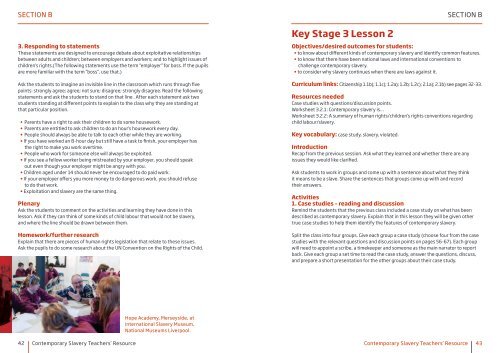
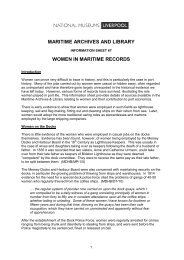
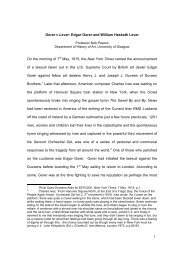
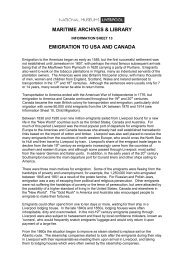
![Ancient Egypt trail [227kb .pdf] - National Museums Liverpool](https://img.yumpu.com/48998817/1/184x260/ancient-egypt-trail-227kb-pdf-national-museums-liverpool.jpg?quality=85)

